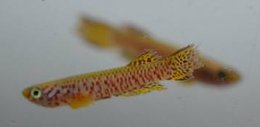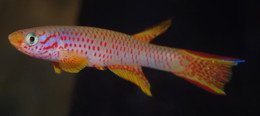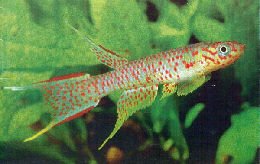| Meaning
of Name |
Elegant |
| First
Description |
Boulenger
1899. Matérieaux pour la faune du Congo,
Tomé I, Poissons nouveaux. Annales du
Musée du Congo belge, 1: 112-114, plate 47, figure 2. |
| Size |
5 cm |
| Meristics |
- D = 8, A = 14, ll = 30-32 (Boulenger 1899)
- D
= 7-9, A = 14-15, D/A = +7-9, ll = 26-29 (Woeltjes 1984)
|
| Karyotype |
n = 10, A = 18 (Huber & Scheel 1981) |
| Sub-Genus |
Aphyosemion |
| Group |
elegans |
| Synonyms |
- Haplochilus elegans
Boulenger 1899
- Panchax
elegans Ahl 1924
- Aphyosemion
elegans Myers 1933
- Aphyosemion
elegans elegans Matthes 1964
- Aphyosemion
NSC - 5 Baker-Carr 1975
|
Populations
- Bombala
- Dédrouillé (northeastern
Congo)
- Ignoli (northern
Congo)
- Inongo
- Lui Kotale
- Madimba
- Mbombokonda
- Mondimbi (central
Zaire)
- Tshuapa - Boende region.?
- AVD 001
- KM14
- NSC 5
- JH 134
- JH 137
Aphyosemion
affinis elegans
- Kwambila
(A.cognatum)
- Sembe
/ Ouesso (a collection from between
these locations in northern Congo)
|
|

A.elegans collected
around Kinshasa
Photo courtesy of Serge Mevellec
|

A.sp.(aff)
elegans AVD 001
Photo courtesy of Karsten Keibel
|
|
Bombala - RPC 83 / 2. Collected
by Christophe Moreau in 1983.
|

Bombala
Photo courtesy of Maurice Chauche & the KCF website.
|
|
|
Inongo - A German effort to get this population
established but it failed before it was distributed. It happens.
JH
134 & 137 - These populations have been erroneously
given as RPC in some articles & were collected by Dr.J.H.Huber (see JH78
code) in northeast Congo-Brazzaville in 1978. These collections lack the red band
in the dorsal fin seen more commonly in collections further to the north. The
red band in the caudal fin is marginal & not submarginal as in other populations.
It is possible these may not be elegans.
Lui Kotale - Collected by Ulrich Schliewen
in 2002 in the Province of Bandundu, Democratic Republic of Congo.He
also collected at Lompolé but these were not brought back to
captivity. A yellow form was also collected at Km 14 which may be elegans.
Axel Schwekendiek broke the news to me on this collection...."The
fishes were caught by accident near Boende, 35 km on the road to to
Yaa (wherever that is). Two people in the DKG received fishes and also
somebody in holland and belgium. Although the fishes were all very small
(subadults), some larger males began to sex out. I really hope that
we can establish the strain in europe soon."
In 2003 these
were considered safe in the DKG.
|
| Type
Locality |
Bikoro (Lake Tumba, Central Congo drainage)
& Mbandaka, central Zaire. Also Coquilhatville,
close to the Congo River (currently Mbandaka).

Line drawing of one of the male type specimens
|
| Distribution |
Widespread distribution across the central Zaire River
drainage. |
| Habitat |
Small, shallow streams & brooks. Also found in swampy
areas of pools & along the shore line of lakes. Prefers shallow water with
slow currents in forested areas.
Stomach contents
of wild fish have showed that they live on ants & aquatic insect larvae.
Reported to live in still, quiet water which is shaded. Fish feed mostly from
the surface on terrestrial insects. |
| Distinguishing
Characteristics |
The main distinguishing character of this sp.
is regarded as the striated body pattern. The photo at the top of this
page clearly shows this.
Scheel reported black outer margins on all unpaired fins.
Reported to have a slender body with long extensions to fins.
The populations from Bikoro, Boende & Coquilhatville have a red
stripe in the dorsal fin. This band is lacking in the RPC 134 &
137 populations more notable in more northerly populations.
Whilst not a distinguishing marking Stan Langdon in BKA newsletter No.186,
February 1981 commented on this sp. ability to 'raise & lower the
dorsal & anal fins so that they look like furled flags at right
angles to the body'.
Boulenger wrote in his work 'Catalogue of the
Freshwater Fishes of Africa in the British Museum (Natural History)'
-'Yellowish or pale olive, brown on the back, most of the scales edged
with carmine; vertical fins with carmine dots & edged with carmine
or dark purple'.
He does not mention the bars on the sides of males. This is also absent
on the original drawing.
|
| Colour/Pattern
Variability |
High |
| History |
Boulenger described Haplochilus
elegans from 3 (Types 1-3) specimens caught by Delhez at
Bikoro on Lake Tumba in 1899.
His type specimens 4-5 were also collected by Delhez but from Coquillatville
(present day Mbandaka).
He also identified 'aquarium fish' in 1911 as belonging to this species
but later changed his mind in favour of A.calliurum.
In 1911 - 1912 he also placed some individuals caught at Kondue, Kasai,
Congo by Luja into elegans but these
were probably used to describe Aphyosemion
lujae.
Boulenger
gives the following collectors / locations in his 1915 Catalogue.
- 1-3 (Types). Collected by M.P.Delhez at Bikoro,
Lake Tumba.
- 4-5. Collected by M.P.Delhez at Coquillatville
(present day Mbandaka).
Nichols
& Griscom in 1917 reported fish caught at Medje, Faradje & Stanleyville
as belonging to elegans. These fish were used
by Myers in 1924 to describe A.castaneum. In
1952 Poll reported having numerous fish caught in affluents to the left of the
Congo (Zaire) River) (Mondimbi, Flandria, Eala, Kunumgu & Bikoro) & also
from Genema, Ubangui drainage. Matthes in 1964
had 82 fish from Lake Tumba. J.Lambert collected
them at Boende about 300 km east of the type locality. These were returned alive
to Belgium. Some of this collection is preserved in the Museum of Central Africa,
Tervuren, Belgium. This collection was known to still be in the hobby in 1973. Known
to be circulating in the BKA in 1980. |
| Breeding
Notes |
Although
they have been seen in auctions now & then they are reportedly a little harder
to breed & maintain following generations. Subdued
lighting seems to be important.
Stan Langdon in BKA newsletter No.186, February
1981 gave the following breeding report. I know Stan, & he is does
nothing but methodical.
A pair were set up in a 12x8x8" tank filled with two thirds rainwater,
one third old tank water. A temperature of 72-74°F was maintained.
Plants were added in the form of Java moss & Ceratopteris.
A sponge filter was also added.
Eggs were laid in the plants but were mostly infertile. Females were
observed to be predatory towards eggs & young fry. Stan fed these
fish white worm which they were particularly fond of.
A water change was tried with the addition of salt but not the usual
teaspoon to a gallon strength. Also added was 2 teaspoons of water which
came from peat standing in water for a time which was very acid (between
pH 3·7 - 4·2).
Egg production started to improve.
Ian Sainthouse commented to Stan that the
fish need to be 8-10 months old before real egg laying occurs.
Stan placed a larger mop in the breeding tank as he considered females
capable of eating eggs.
Eggs were collected & placed in rainwater, tank water & boiled
tap water in glass & plastic containers but all fungussed. Another
approach was tried using semi dry storage by squeezing a handful of
peat until just moist & laying in a container. Eggs were placed
on top of this & stored at 70-75°F for up to 4 weeks. A few
eggs fungussed but the majority developed normally. After a week eyes
could be observed in the eggs. After 14 days of semi dry storage a hatching
was attempted. Old neutral rainwater was used. Fry started emerging
in 3-4 days. When transferring fry to another container losses were
reported as being heavy. Fry allowed to escape into a tank containing
the same water used to hatch the eggs was found to be a success.
At 3 months of age males started to show red stripes. At 6 months sparing
& breeding attempts was observed.
Stan also used this method with A.christyi
to good effect.
At the 2003 BKA convention I had a talk with
Ian Sainthouse on how the old BKA import of this sp. was bred &
he informed me that eggs should be incubated on a bed of wet peat for
success. Water incubation resulted in most if not all eggs disintegrating.
|
| Diameter
of Egg |
0.9mm |
| Remarks |
Care should be excercised in putting fish into new surroundings.
A towel should be placed over the tank to keep it dark for a few days as this
sp. seem to dislike new surroundings. Males
will extend finnage in fighting posture but damage between males has been reported
as being minimal. |



